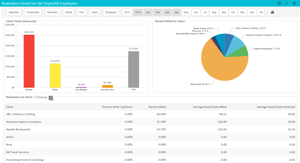Client Investment or Extortion?

Every agency strives to act like and be considered a partner for their clients - not a vendor. The difference being that vendors just sell you something. They're not concerned about your business, they're not invested in your success and they're not interested in building a relationship with you unless by that you mean keeping your credit card on file so they can auto-charge your next order.
A partner thinks and acts differently. They care about the client's business as if it were their own. They learn everything they can about the business. They want to be involved in the business decisions and they're invested in the business both emotionally (via strong relationships) and financially (via un-billed time).
 Most clients today expect partnership from their agencies which includes the aforementioned "client investment" of un-billed time and effort that go beyond contract stipulations and SOWs. In fact, some agencies actually include the expectation of "client investment" in their contracts and proposals as a way of helping secure new business (especially since they know they're going to wind up doing it anyway, so you may as well be open about it and get credit for it).
Most clients today expect partnership from their agencies which includes the aforementioned "client investment" of un-billed time and effort that go beyond contract stipulations and SOWs. In fact, some agencies actually include the expectation of "client investment" in their contracts and proposals as a way of helping secure new business (especially since they know they're going to wind up doing it anyway, so you may as well be open about it and get credit for it).
But there's a line that gets crossed when the decision to invest (aka not bill) time or resources in a client moves out of the agency's hands and into the client's. Something akin to telling your employees they're going to work a 60 hour week but only bill you for 40. That's when "client investment" starts looking and sounding more like extortion than investment. How do you avoid or control that from happening?
Based on decades of experience, this tends to be most common in two situations; where the agency is on a project-based engagement and when the primary clients managing the agency relationship are below the Director level. Clients who keep their agencies on a project-by-project basis often expect them to "pitch" for every new assignment. Each agency winds up essentially completing the assignment on spec, hoping that theirs will be the creative chosen and they'll actually be able to bill for the work they did. The other agencies get to chalk up their pitching costs to "client investment" since you can only bill the "new business" job number so many times for an existing client...
 A more common and egregious example occurs when inexperienced clients are put in charge of the agency relationship. These individuals, in an effort to show outstanding performance for their superiors, often make extortionist requests of the agency, such as requiring the agency team attend a conference, event or other function but specifically state that they do not want to be billed for the time. Another example could be expanding the deliverables for a project but refusing to change the SOW or increase the approved budget for the project. Or even cajoling the agency into doing spec strategy and creative work for the client's own pet projects that don't even have a SOW.
A more common and egregious example occurs when inexperienced clients are put in charge of the agency relationship. These individuals, in an effort to show outstanding performance for their superiors, often make extortionist requests of the agency, such as requiring the agency team attend a conference, event or other function but specifically state that they do not want to be billed for the time. Another example could be expanding the deliverables for a project but refusing to change the SOW or increase the approved budget for the project. Or even cajoling the agency into doing spec strategy and creative work for the client's own pet projects that don't even have a SOW.
How can you reduce or eliminate this kind of behavior while building an actual partnership with your clients? We believe the answer is transparency. Quantifiable transparency.
The key to quantifiable transparency is accurately capturing and recording the investment you make in the client's business. Every un-billed phone call, happy hour, strategy session, project overage, spec creative and weekend work needs to be captured and documented so you have the hard data to share. Hopefully, your timekeeping system gives you the tools necessary to do so. If not, consider a mobile-based solution like the RecordTime app that allows employees to capture their time by simply speaking to their phone. Whatever you use, you need to make sure that the data gets into your system.
 Then you want to make a regular practice of showing it to the clients. Usually once a quarter is sufficient. Show them in great detail how committed you are to their business and how much you're investing in it. This becomes particularly interesting when you compare it to how much you're actually billing them. It can be a humbling experience for the clients and it can change the way they treat the agency. This is especially effective if C-level clients attend the presentation. Executive leadership tends to look at the agency's investment in a different light and understand the real cost to the firm. They're the first to recognize extortionist behavior and the first to put a stop to it.
Then you want to make a regular practice of showing it to the clients. Usually once a quarter is sufficient. Show them in great detail how committed you are to their business and how much you're investing in it. This becomes particularly interesting when you compare it to how much you're actually billing them. It can be a humbling experience for the clients and it can change the way they treat the agency. This is especially effective if C-level clients attend the presentation. Executive leadership tends to look at the agency's investment in a different light and understand the real cost to the firm. They're the first to recognize extortionist behavior and the first to put a stop to it.
 How you present the information is also important. It's a fine line between sharing the details about how much you're investing in the client's business and coming across as complaining or angling for more money. The data needs to be presented as part of the larger status on the client's business - all projects included - instead of as a separate subject.
How you present the information is also important. It's a fine line between sharing the details about how much you're investing in the client's business and coming across as complaining or angling for more money. The data needs to be presented as part of the larger status on the client's business - all projects included - instead of as a separate subject.
"One of the best features of the AQUA agency management system is the variety of options and formats available for user-defined reports and dashboards." states Ellen Coulter, President of Advantage Software. "Because our software is written specifically for agencies, we have an Advanced Report Writer that helps you break out the details of your fees so you can present your client investment holistically within the context of all the work you do for that client."
 Quantitative transparency can help you convert an extortionist client investment situation into a partnership where everyone realizes the true value of what each is bringing to the table. It's time every agency is recognized for the partnership they provide and the investment they make in their clients' businesses.
Quantitative transparency can help you convert an extortionist client investment situation into a partnership where everyone realizes the true value of what each is bringing to the table. It's time every agency is recognized for the partnership they provide and the investment they make in their clients' businesses.
Quantitative transparency requires an agency management system that can provide you with the data capture and reporting necessary to present your investment in a professional and integrated fashion. Advantage's AQUA agency management system has all the capabilities you'll need and more. Schedule a free online demonstration and see how the system can help your agency be a better partner to all your clients.


